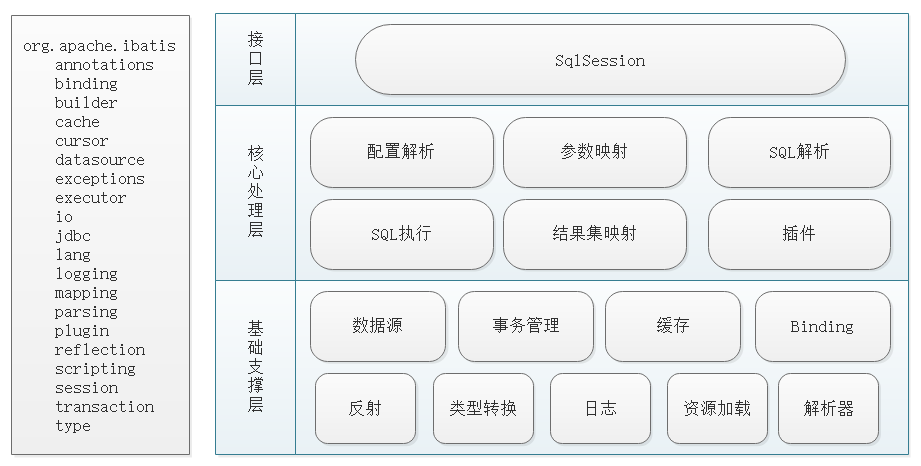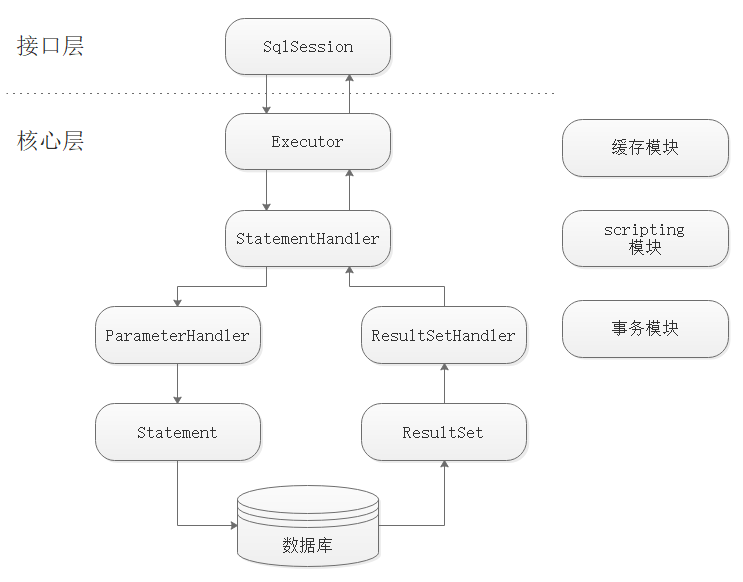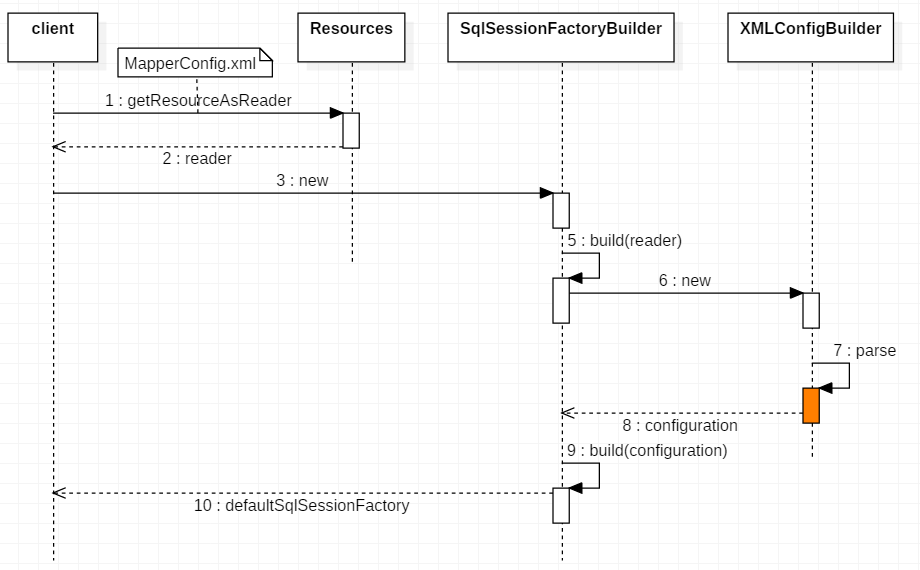mybatis 源码分析(一)框架结构概览
本篇博客将主要对 mybatis 整体介绍,包括 mybatis 的项目结构,执行的主要流程,初始化流程,API 等各模块进行简单的串联,让你能够对 mybatis 有一个整体的把握。另外在 mybatis 源码的阅读过程中,如果不想写 demo 可以直接使用项目中的单元测试;
一、mybatis 结构介绍
mybatis的主要功能和使用 demo,在网上已经有很多了我就不再啰嗦了,同时 官方文档 也非常的详细;另外 mybatis 中使用了多种设计模式,包括建造者、动态代理、策略、装饰器模式等,在查看源码的时候,最好先对这些设计模式有一定的了解;
其中 mybatis 的模块结构如下:

mybatis 的执行流程如下:
- 首先通过 Java API 或者 XML 配置完成初始化,最终所有的配置都在 Configuration 类中维护;
- 然后通过 SqlSessionFactory 得到 SqlSession,这里 SqlSession 就是 mybatis 的顶层 API 了,主要通过他完成数据库的增删改查等操作;
- 然后 SqlSession 将具体的操作委托给 Executor 执行,Executor 就是 mybatis 的调度核心了,主要职责有 SQL 语句生成、一二级缓存维护和事务的相关操作;
- 然后 Executor 将数据库相关的操作委托给 StatementHandler,StatementHandler 中完成了 mybatis 最核心的工作,包括参数绑定,指定 SQL 语句,结果集映射等;
具体过程如图所示:

二、初始化
mybatis 中包含了很多的配置项,具体每一项的讲解 官网 也很详细,其结构大致如下:(另外正如上面说的 mybatis 的配置项最后都由 Configuration 类维护,这其实就是外观模式)
configuration(配置)properties(属性)settings(设置)typeAliases(类型别名)typeHandlers(类型处理器)objectFactory(对象工厂)plugins(插件)environments(环境配置)environment(环境变量)transactionManager(事务管理器)dataSource(数据源)mappers(映射器)
1. Java API 初始化
Java API 初始化的方式虽然不常用,但是相较于 XML 的方式可以更清楚的看到 Configuration 的构成,其示例如下:
PooledDataSource dataSource = new PooledDataSource();dataSource.setDriver("com.mysql.cj.jdbc.Driver");dataSource.setUrl("jdbc:mysql://localhost:3306/mybatis?serverTimezone=GMT");dataSource.setUsername("root");dataSource.setPassword("root");TransactionFactory transactionFactory = new JdbcTransactionFactory();Environment environment = new Environment("development", transactionFactory, dataSource);Configuration configuration = new Configuration(environment);configuration.addMapper(UserMapper.class);sqlSessionFactory = new SqlSessionFactoryBuilder().build(configuration);
2. XML 配置初始化
相交于 Java API 的方式,XML 配置初始化,必然会多出 XML 的解析部分;代码如下:
String resource = "org/apache/ibatis/builder/MapperConfig.xml";Reader reader = Resources.getResourceAsReader(resource);SqlSessionFactory sqlSessionFactory = new SqlSessionFactoryBuilder().build(reader);SqlSession sqlSession = sqlSessionFactory.openSession();
下面是一个相对完整的配置示例:
<?xml version="1.0" encoding="UTF-8" ?><!DOCTYPE configuration PUBLIC "-//mybatis.org//DTD Config 3.0//EN" "http://mybatis.org/dtd/mybatis-3-config.dtd"><configuration><properties resource="org/apache/ibatis/databases/blog/blog-derby.properties"/><settings><setting name="cacheEnabled" value="true"/><setting name="lazyLoadingEnabled" value="false"/>...</settings><typeAliases><typeAlias alias="Author" type="org.apache.ibatis.domain.blog.Author"/><typeAlias alias="Blog" type="org.apache.ibatis.domain.blog.Blog"/>...</typeAliases><typeHandlers><typeHandler javaType="String" jdbcType="VARCHAR" handler="org.apache.ibatis.builder.CustomStringTypeHandler"/></typeHandlers><objectFactory type="org.apache.ibatis.builder.ExampleObjectFactory"><property name="objectFactoryProperty" value="100"/></objectFactory><plugins><plugin interceptor="org.apache.ibatis.builder.ExamplePlugin"><property name="pluginProperty" value="100"/></plugin></plugins><environments default="development"><environment id="development"><transactionManager type="JDBC"><property name="" value=""/></transactionManager><!--<dataSource type="UNPOOLED">--><dataSource type="POOLED"><property name="driver" value="${driver}"/><property name="url" value="${url}"/><property name="username" value="${username}"/><property name="password" value="${password}"/></dataSource></environment></environments><mappers><mapper resource="org/apache/ibatis/builder/AuthorMapper.xml"/><mapper resource="org/apache/ibatis/builder/BlogMapper.xml"/>...</mappers></configuration>
其解析的流程如下:

主要代码如下:
public SqlSessionFactory build(InputStream inputStream, String environment, Properties properties) {try {XMLConfigBuilder parser = new XMLConfigBuilder(inputStream, environment, properties);return build(parser.parse());} catch (Exception e) {throw ExceptionFactory.wrapException("Error building SqlSession.", e);} finally {ErrorContext.instance().reset();try {inputStream.close();} catch (IOException e) { }}}public SqlSessionFactory build(Configuration config) {return new DefaultSqlSessionFactory(config);}
从上面的代码和流程图中可以看到,XML 初始化的主要流程被封装到了 XMLConfigBuilder 当中;主要的代码逻辑如下:
public Configuration parse() {if (parsed) { throw new BuilderException("Each XMLConfigBuilder can only be used once."); }parsed = true;parseConfiguration(parser.evalNode("/configuration"));return configuration;}private void parseConfiguration(XNode root) {try {//issue #117 read properties firstpropertiesElement(root.evalNode("properties"));Properties settings = settingsAsProperties(root.evalNode("settings"));loadCustomVfs(settings);loadCustomLogImpl(settings);typeAliasesElement(root.evalNode("typeAliases"));pluginElement(root.evalNode("plugins"));objectFactoryElement(root.evalNode("objectFactory"));objectWrapperFactoryElement(root.evalNode("objectWrapperFactory"));reflectorFactoryElement(root.evalNode("reflectorFactory"));settingsElement(settings);// read it after objectFactory and objectWrapperFactory issue #631environmentsElement(root.evalNode("environments"));databaseIdProviderElement(root.evalNode("databaseIdProvider"));typeHandlerElement(root.evalNode("typeHandlers"));mapperElement(root.evalNode("mappers"));} catch (Exception e) {throw new BuilderException("Error parsing SQL Mapper Configuration. Cause: " + e, e);}}
三、SqlSession 使用方式
1. 直接指定 MappedStatement
try (SqlSession session = sqlMapper.openSession()) {Author author = session.selectOne("org.apache.ibatis.domain.blog.mappers.AuthorMapper.selectAuthor", new Author(101));}
这种方式通过 namespace + sqlId 的方式直接指定 MappedStatement;这种方式因为直接编写字符串和强类型转换,既不安全也稍显麻烦,所以现在已经不推荐使用了;
@Overridepublic <T> Cursor<T> selectCursor(String statement, Object parameter, RowBounds rowBounds) {try {MappedStatement ms = configuration.getMappedStatement(statement);Cursor<T> cursor = executor.queryCursor(ms, wrapCollection(parameter), rowBounds);registerCursor(cursor);return cursor;} catch (Exception e) {throw ExceptionFactory.wrapException("Error querying database. Cause: " + e, e);} finally {ErrorContext.instance().reset();}}
2. 动态代理 Mapper 的方式
try (SqlSession session = sqlMapper.openSession()) {AuthorMapper mapper = session.getMapper(AuthorMapper.class);Author author = mapper.selectAuthor(500);}
这种方式不经避免了以上的问题,同时也能够使用注解的方式编写 sql,而且可以使用 IDE 提示;现在一般都推荐使用这种方式;但是其最终也是调用了上面的接口;
首先在初始化的时候通过 bindMapperForNamespace,注册对应的 Mapper(要求namespace和Mapper的全限定名保持一致);
// XMLMapperBuilderprivate void bindMapperForNamespace() {String namespace = builderAssistant.getCurrentNamespace();if (namespace != null) {Class<?> boundType = null;try {boundType = Resources.classForName(namespace);} catch (ClassNotFoundException e) { //ignore, bound type is not required }if (boundType != null) {if (!configuration.hasMapper(boundType)) {configuration.addLoadedResource("namespace:" + namespace);configuration.addMapper(boundType);}}}}// MapperRegistrypublic <T> void addMapper(Class<T> type) {if (type.isInterface()) {if (hasMapper(type)) { throw new BindingException("Type " + type + " is already known to the MapperRegistry."); }boolean loadCompleted = false;try {knownMappers.put(type, new MapperProxyFactory<>(type)); // 添加代理工厂MapperAnnotationBuilder parser = new MapperAnnotationBuilder(config, type);parser.parse();loadCompleted = true;} finally {if (!loadCompleted) {knownMappers.remove(type);}}}}
使用的时候,通过 class 类名获取 MapperProxyFactory 代理工厂,制造一个新的 Mapper 代理(注意这里时每次都要生成一个代理类,因为其中包含了 SqlSession,而 SqlSession 是线程不安全的所以不能缓存,但是我觉得这里任然是可以优化的,有兴趣你可以自己尝试一下);
try (SqlSession session = sqlMapper.openSession()) {AuthorMapper mapper = session.getMapper(AuthorMapper.class); // 代理类}// MapperRegistrypublic <T> T getMapper(Class<T> type, SqlSession sqlSession) {final MapperProxyFactory<T> mapperProxyFactory = (MapperProxyFactory<T>) knownMappers.get(type);if (mapperProxyFactory == null) { throw new BindingException("Type " + type + " is not known to the MapperRegistry."); }try {return mapperProxyFactory.newInstance(sqlSession); // 创建代理对象} catch (Exception e) {throw new BindingException("Error getting mapper instance. Cause: " + e, e);}}// MapperProxyFactorypublic T newInstance(SqlSession sqlSession) {final MapperProxy<T> mapperProxy = new MapperProxy<>(sqlSession, mapperInterface, methodCache);return newInstance(mapperProxy);}// MapperProxypublic Object invoke(Object proxy, Method method, Object[] args) throws Throwable {try {if (Object.class.equals(method.getDeclaringClass())) { // 从Object中继承的方法return method.invoke(this, args);} else if (method.isDefault()) { // 有默认实现的接口方法return invokeDefaultMethod(proxy, method, args);}} catch (Throwable t) {throw ExceptionUtil.unwrapThrowable(t);}final MapperMethod mapperMethod = cachedMapperMethod(method);return mapperMethod.execute(sqlSession, args); // 然后由 MapperMethod 执行,这里使用策略模式,后面还会详细讲解}
总结
SqlSession 是线程不安全的,所以在示例代码中每次使用都会将其关闭?
在 mybatis 中还有一个类 SqlSessionManager 里面有一个 ThreadLocal 用来管理 SqlSession,在 Spring 中也同样是用 SqlSessionHolder 来管理的,所以并不会每次都创建一个新的 SqlSession;
以上内容只是大致将了 mybatis 的主要结构,后面的章节还会分模块进行讲解;
另外本文主要参考了《MyBatis技术内幕》,有兴趣的可以自行查看;
mybatis 源码分析(一)框架结构概览的更多相关文章
- MyBatis源码分析-MyBatis初始化流程
MyBatis 是支持定制化 SQL.存储过程以及高级映射的优秀的持久层框架.MyBatis 避免了几乎所有的 JDBC 代码和手动设置参数以及获取结果集.MyBatis 可以对配置和原生Map使用简 ...
- MyBatis源码分析-SQL语句执行的完整流程
MyBatis 是支持定制化 SQL.存储过程以及高级映射的优秀的持久层框架.MyBatis 避免了几乎所有的 JDBC 代码和手动设置参数以及获取结果集.MyBatis 可以对配置和原生Map使用简 ...
- MyBatis源码分析(5)——内置DataSource实现
@(MyBatis)[DataSource] MyBatis源码分析(5)--内置DataSource实现 MyBatis内置了两个DataSource的实现:UnpooledDataSource,该 ...
- MyBatis源码分析(4)—— Cache构建以及应用
@(MyBatis)[Cache] MyBatis源码分析--Cache构建以及应用 SqlSession使用缓存流程 如果开启了二级缓存,而Executor会使用CachingExecutor来装饰 ...
- MyBatis源码分析(3)—— Cache接口以及实现
@(MyBatis)[Cache] MyBatis源码分析--Cache接口以及实现 Cache接口 MyBatis中的Cache以SPI实现,给需要集成其它Cache或者自定义Cache提供了接口. ...
- MyBatis源码分析(2)—— Plugin原理
@(MyBatis)[Plugin] MyBatis源码分析--Plugin原理 Plugin原理 Plugin的实现采用了Java的动态代理,应用了责任链设计模式 InterceptorChain ...
- 【MyBatis源码分析】select源码分析及小结
示例代码 之前的文章说过,对于MyBatis来说insert.update.delete是一组的,因为对于MyBatis来说它们都是update:select是一组的,因为对于MyBatis来说它就是 ...
- MyBatis源码分析之环境准备篇
前言 之前一段时间写了[Spring源码分析]系列的文章,感觉对Spring的原理及使用各方面都掌握了不少,趁热打铁,开始下一个系列的文章[MyBatis源码分析],在[MyBatis源码分析]文章的 ...
- Mybatis源码分析-BaseExecutor
根据前文Mybatis源码分析-SqlSessionTemplate的简单分析,对于SqlSession的CURD操作都需要经过Executor接口的update/query方法,本文将分析下Base ...
- Mybatis源码分析-StatementHandler
承接前文Mybatis源码分析-BaseExecutor,本文则对通过StatementHandler接口完成数据库的CRUD操作作简单的分析 StatementHandler#接口列表 //获取St ...
随机推荐
- 嵊州D3T2 福尔贝斯太太的快乐夏日 summer
宗教,或是无节制的自由主义,是致人腐化的毒剂. 现在,一个人要经历 n 个事件,编号为 1 ∼ n. 经历 x 号事件,他的危险值就会增加 x. 一开始他的危险值是 0. 当一个人的危险值大于 0 且 ...
- SQL Server 根据日期分组、 根据时间段分组(每三个小时一组)
所用数据表: 一.根据日期分组 1. 使用convert() 函数方式 --根据年月 ),CreatTime,)日期,COUNT(*) 次数,sum(Money)总数 from Orders ),Cr ...
- 基于SpringCloud的Microservices架构实战案例
@import url(http://i.cnblogs.com/Load.ashx?type=style&file=SyntaxHighlighter.css);@import url(/c ...
- 基于webpack4+vue-cli3项目的换肤功能
起因 最近因公司需求,需要实现主题换肤功能,不仅仅是颜色的更改,还需要包括图片,字体等文件等更换,因此在百度里各种实现方案后,决定根据scss+style-loader/useable做换肤. 项目开 ...
- MyBatis 一对多映射
From<MyBatis从入门到精通> <!-- 6.1.2.1 collection集合的嵌套结果映射 和association类似,集合的嵌套结果映射就是指通过一次SQL查询将所 ...
- Netty-新连接接入源码解读
本片博文来看Netty的服务端是如何处理新连接接入问题的 什么是新连接接入?以及新连接接入前,Netty处于什么状态 netty的服务端NioServerSocketChannel初始化,注册在Bos ...
- [记录]Linux下大批量添加用户的方法
Linux系统提供了创建大量用户的工具,可以让您立即创建大量用户,方法如下: (1)先编辑一个文本用户文件. 每一列按照/etc/passwd密码文件的格式书写,要注意每个用户的用户名.UID.宿主目 ...
- 【原创】一个shell脚本记录(实现rsync生产文件批量迁移功能)
#!/bin/bash #Date:2018-01-08 #Author:xxxxxx #Function:xxxxxx #Change:2018-01-17 # #设置忽略CTRL+C信号 trap ...
- 【带着canvas去流浪(12)】用Three.js制作简易的MARVEL片头动画(上)
目录 一. 大作业说明 二.基本思路 三.视频纹理表面修复--UV映射 3.1 问题描述 3.2 纹理贴图的基本原理-UV映射 3.3 关键示例代码 四.小结 示例代码托管在:http://www.g ...
- 洛谷P1640 [SCOI2010]连续攻击游戏 题解
题目链接: https://www.luogu.org/problemnew/show/P1640 分析: 这道题用二分图来解决即可.应该可以作为网络流中的模板题来食用, 每一个武器有两个属性,但是只 ...
